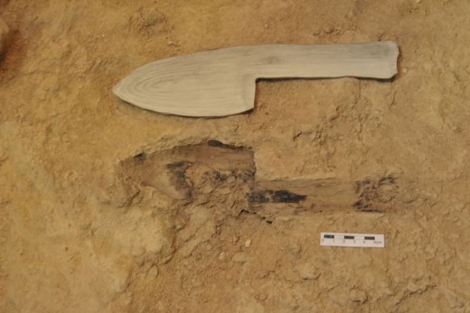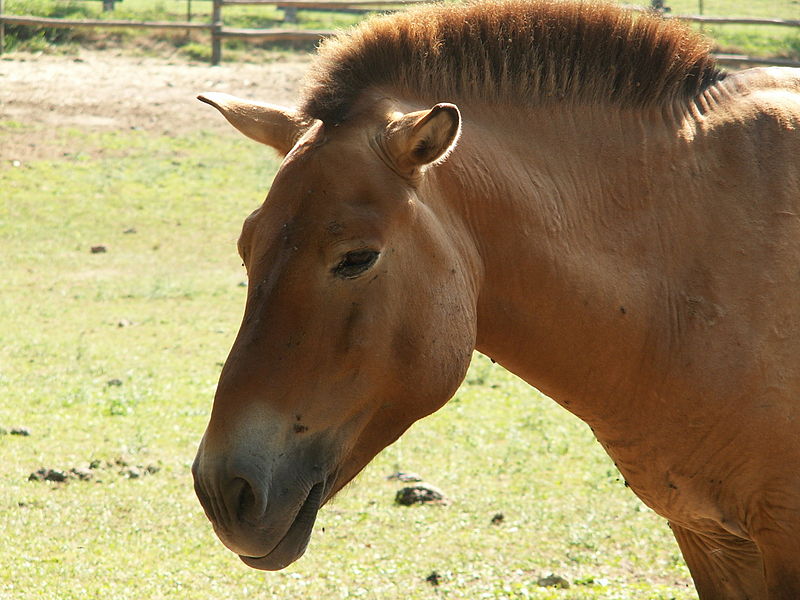Follow here a series of links and comments on issues that are of some prehistoric or genetic interest (plus a well fed section of astronomy news this time), which I have got no time to deal with so far... or do not come with enough info to merit a separate entry... or are not of great interest to me.
Neanderthal trowel at Abric Romaní (Catalonia)
 |
| Print and reconstruction of the trowel |
The almost hollow print of what once was a trowel (or similar) has been found at the important Paleolithic cave of Abric Romaní (Capellanes, Catalonia). The print came with some residues which indicate that the instrument was left at the fire when it was already off, so it did only burn superficially, later being deprived of oxygen by water and moss.
The artifact's length is of 32 cm, with a maximum width of 8 cm and may have been used to manage the fire. It is dated to 56,000 years ago.
More mammoth petroglyphs in North America
I recently mentioned a mammoth engraving from Florida, which should be from c. 13,000 BP. Another place where such engravings seem to exist is San Juan River, near Bluff (Utah).
That is what Ekkehart Malotki and Henry D. Wallace argue in a paper published at Stone Pages, which includes many images of petroglyphs, only a few of which look like mammoths, one of them very clearly so.
 |
| The mammoth (left, eroded) has a bison partially superimposed (right) |
··> PDF at Stone Pages.
Opium ritual and medicinal use in Iberian Neolithic
 |
| Ritual use was some times associated to these idols |
The opium poppy grows spontaneously in most of Europe, specially in the Mediterranean. I was knowledgeable that Western Danubian farmers had grown and used this narcotic in Germany and nearby areas but this is the first explicit reference I know of its use in the Mediterranean basin or the Iberian peninsula.
Sadly this material is in Spanish language and I don't have room nor time here to deal with it properly. Hopefully later on.
The evidence of use of this drug is analyzed in several sites, most of them in Andalusia but also from Catalonia...
··> B. Gavilán Ceballos, USO RITUAL Y MEDICINAL DE LA PAPAVER SOMNIFERUM EN EL NEOLITICO DE LA PENINSULA IBERICA (UNED, 2007). Found at Pileta de Prehistoria[es].
Paleolithic findings from Triacastela, Galicia
Pileta de Prehistoria[es] also tells us of research in a relatively ill-documented region: Galicia. The findings at Triacastela are from the Middle Paleolithic (Neanderthals) and Upper Paleolithic (H. sapiens). From this last period a decorated dart has been found:
Documentary on destroyed archaeological site
The last bit I want to highlight from Pileta is a documentary (in Spanish) on the destruction by private businesspeople of the archaeological patrimony of the cave of Chaves (Aragon). I already mentioned this crime against humankind in 2010 at my old blog.
··> Chaves la Memoria expoliada (video at Pileta de Prehistoria, in Spanish, 55 mins).
Archaic immune introgression?
I mentioned in June some speculation on HLA (immune system) introgression from Neanderthals or other archaic Homo in Asia. The corresponding paper has been published with more data but is pay per view (supp. material is accessible however). Back in the day I thought it looked at least partly unlikely (as the corresponding haplotypes are in some cases found in Africa).
Przewalski horses at the origin of domesticated horse Y-DNA
While horse mtDNA is most diverse and suggests many origins, all known Y-DNA comes from a single lineage... which happens to be related to that of the Przewalski wild horses of Mongolia via an ancient intermediate lineage located at Tuva Republic.
Ancient wild horses from Siberia and Alaska however had much greater Y-DNA diversity.
Tunisian lineages
Dienekes mentions two new papers on Tunisian Y-DNA (and one of them also on mtDNA), yet they are both pay per view and the announced results seem not really novel. Anyhow, for the reference, they are:
- Karima Fadhlaoui-Zid et al., Genetic structure of Tunisian ethnic groups revealed by paternal lineages. AJPA 2011.
- H. Enafaa et al., Mitochondrial DNA and Y-chromosome microstructure in Tunisia. Nature 2011.
Snow White and the red apple
 |
| Artistic rendering of Snow White |
Unnamed Dwarf Planet (Snow White 2007 OR10) gives us some new information on itself and the Kuiper Belt. To begin with Snow White happens to be red in fact, what requires some explanation.
Mike Brown, the man who demoted Pluto and discovered Eris, Sedna and a host of other Transneptunian objects, explains it in detail in three successive entries at his blog: The redemption of Snow White (part 1, part 2 and part 3).
Also news story at Science Daily.
Panspermia? Yes but from Earth outwards
Panspermia is the theory that proposes that life (in its primitive forms) may have arrived to Earth from outer space. Modeling of meteorite impacts however suggest that the opposite may also be true. These impacts could well have ejected materials with terrestrial life such as bacteria or even those hardy water bugs known as tardigrades, which can withstand almost anything.
So 'earthling' life may already exist on Mars, Venus or other planets, moons or asteroids of the Solar System... and there was no need for human-made spacecrafts for them to make such journeys.
Direct evidence will have to wait however: it is just a model.
··> BBC.
Diamond planet
Extremely compressed carbon seems to be what a planet, once a white dwarf star, is made of. That is like saying that the whole planet is the largest known diamond ever.
Sadly for those thinking about mining it, it lays at 4000 light-years of distance, 1/8 of the path from here to the Galactic Center.
··> SD.


























